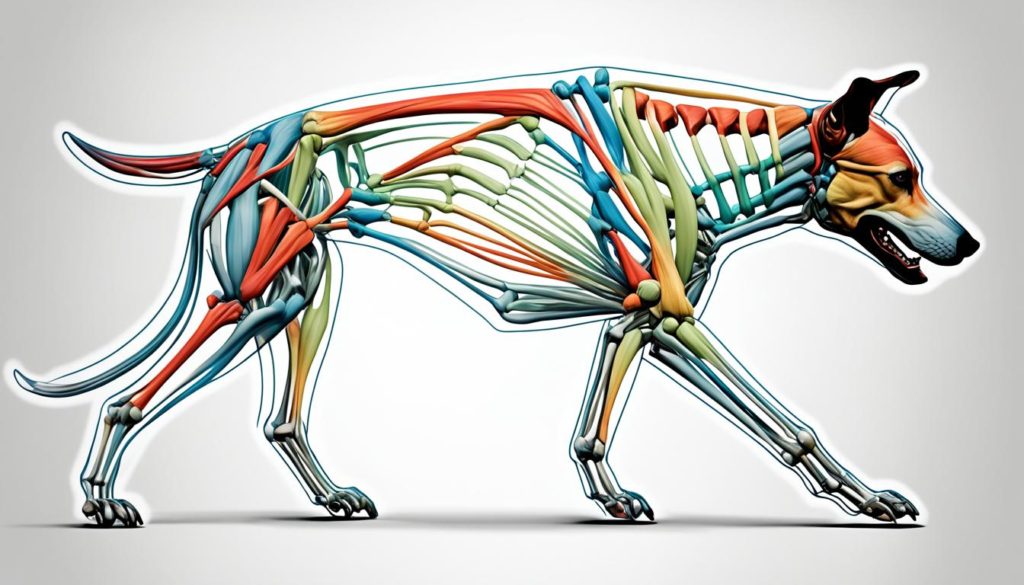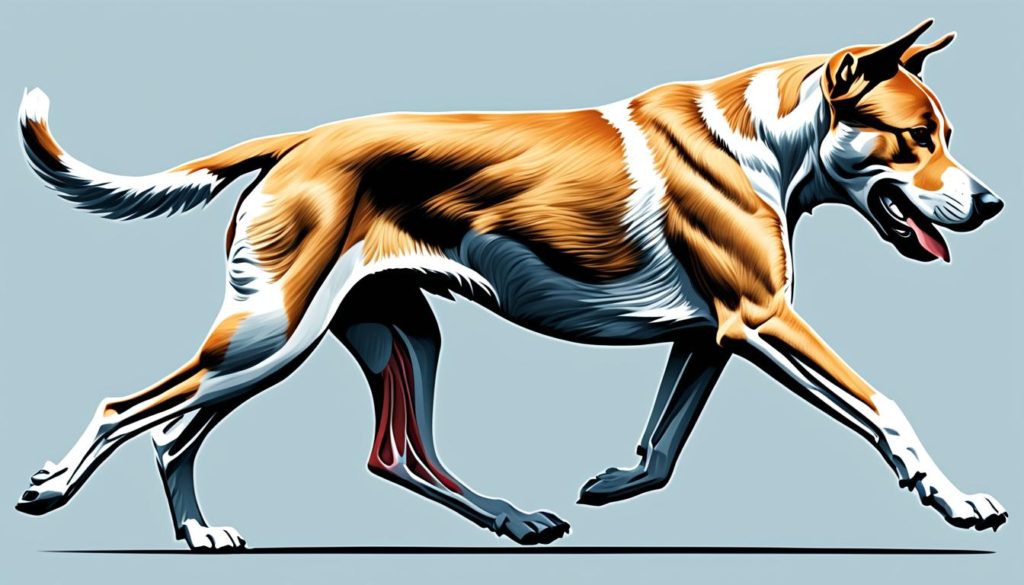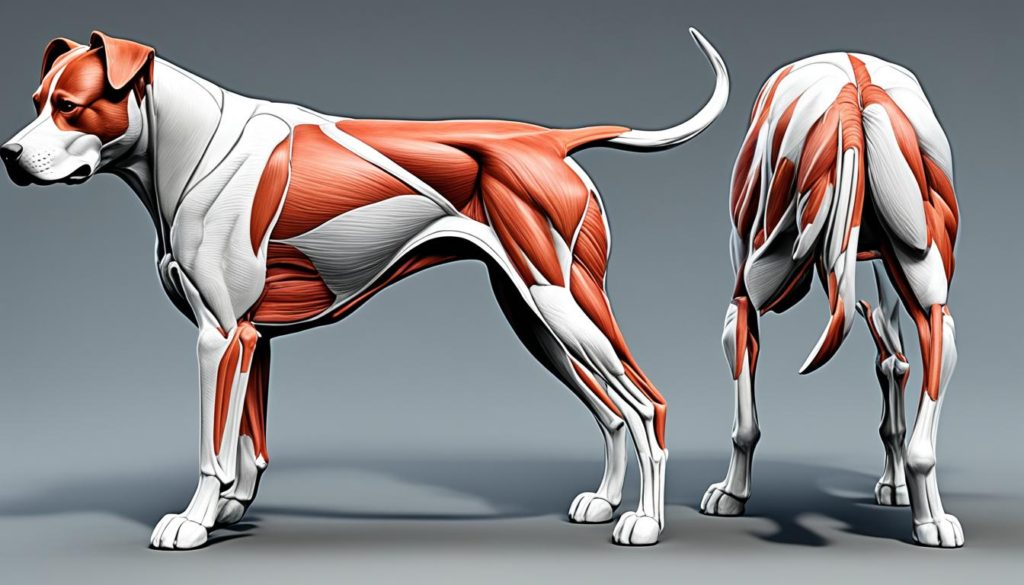With their incredible athleticism and boundless energy, dogs bring joy and companionship to our lives. As responsible pet owners, it is essential to understand the intricate workings of our canine friends’ bodies, including their muscle anatomy. By delving into the dog’s muscular system and exploring their muscle structure and groups, we can gain valuable insights into their overall health and well-being.
Understanding a dog’s conformation and muscle anatomy is crucial for several reasons. Firstly, it allows us to prevent injuries by identifying weak areas and working on strengthening them. Secondly, it enables us to recognize any potential issues that may arise due to genetics or breed-specific characteristics. Finally, a deeper understanding of canine muscle anatomy helps us optimize their training and exercise routines, ensuring their physical development and performance.
Key Takeaways:
- Understanding your dog’s muscle anatomy is essential for their well-being.
- By identifying weak areas, you can prevent injuries and promote overall health.
- Each breed has unique muscle structure and groups.
- Optimizing training and exercise routines based on muscle anatomy can enhance performance.
- Consulting a veterinarian or professional trainer can provide valuable insights into your dog’s specific needs.
Gait Analysis and Muscle Function
The way a dog is constructed reveals itself in how the dog moves, which is why dogs are evaluated both standing and moving at dog shows. The trot is a rhythmic two-beat diagonal gait that is easy for the dog to keep balanced and is ideal for traversing large distances. Watching a dog trot from the side can give you a wealth of information about how that dog is structured. Any imbalance or shortcoming in a dog’s structure can contribute to the dog breaking down over time. Understanding the function of dog muscles is essential in evaluating their movement and structure.
The dog’s movement is a result of the coordinated effort of various muscles, working in harmony to produce efficient locomotion. Dog muscle function involves the contraction and relaxation of muscle fibers, allowing the dog to walk, run, and perform various physical activities. These muscle fibers are made up of specialized cells that enable muscle movement.
The composition of dog muscles is primarily composed of muscle fibers, connective tissue, blood vessels, and nerves. The muscle fibers are responsible for generating force and generating movement, enabling the dog to perform daily activities and engage in exercise.
Understanding the different types of dog muscle fibers is crucial for evaluating their function. There are two main types of muscle fibers in dogs:
- Slow-twitch muscle fibers: These fibers are designed for endurance activities such as trotting or long-distance running. They contract slowly but are highly resistant to fatigue. Slow-twitch fibers are rich in capillaries and mitochondria, allowing them to generate energy aerobically through oxidative processes.
- Fast-twitch muscle fibers: These fibers are responsible for generating quick bursts of power and speed, enabling dogs to perform activities that require rapid movements such as sprinting or jumping. Fast-twitch fibers contract quickly but fatigue faster compared to slow-twitch fibers. They rely on anaerobic metabolism to generate energy.
The precise composition of dog muscles and the ratio of slow-twitch to fast-twitch muscle fibers determine the dog’s abilities and limitations in terms of endurance, speed, and strength.
Gait analysis plays a significant role in assessing a dog’s muscle function, as it involves observing their movement patterns and evaluating muscle coordination. By monitoring the dog’s gait, veterinarians, trainers, and owners can identify any abnormalities or issues with muscle function, allowing for early intervention and appropriate management.
Bones and Joints of the Canine Front Limb
The canine front limb is composed of several bones that work together to support and enable movement. Understanding the anatomy of these bones and their respective joints is essential in comprehending the overall muscle anatomy and function of the dog’s front limb.
The bones in the canine front limb include:
- Scapula
- Humerus
- Radius
- Ulna
- Carpus
- Metacarpals
- Phalanges
Each bone plays a crucial role in the stability, flexibility, and range of motion of the limb. For example, the scapula forms the shoulder blade, providing the attachment point for various muscles responsible for shoulder movement. The humerus connects the scapula to the radius and ulna, forming the upper arm and elbow joint.
The joints of the canine front limb are equally important in facilitating fluid movement. Key joints include the:
- Scapulo-trunk joint: Joins the scapula to the trunk, allowing the front limb to move in coordination with the body.
- Shoulder joint: Connects the scapula to the humerus, enabling a wide range of movement for the front limb.
- Elbow joint: Joins the humerus to the radius and ulna, facilitating bending and extension of the forearm.
- Carpal joint: Located in the wrist, this joint provides flexibility for the paw and helps absorb shock during movement.
Understanding the bones and joints of the canine front limb is fundamental to grasping the broader picture of dog skeletal muscle anatomy and the interplay between muscle groups in facilitating movement and stability.

| Bone | Function |
|---|---|
| Scapula | Forms the shoulder blade and provides attachment point for shoulder muscles |
| Humerus | Connects the scapula to the radius and ulna, forming the upper arm and elbow joint |
| Radius | Runs from the elbow to the carpus, providing support and range of motion |
| Ulna | Runs parallel to the radius, contributing to forearm stability and motion |
| Carpus | Consists of several small bones in the wrist that allow flexibility for paw movement |
| Metacarpals | Long bones that connect the carpus to the phalanges, providing support for the paw |
| Phalanges | Small bones that make up the toes, assisting in balance and locomotion |
Muscles of the Canine Front Limb
The muscles of the canine front limb play a crucial role in facilitating movement and providing support to the limb. Understanding the dog muscle anatomy and the different muscle groups involved is essential to comprehending the overall function of the canine muscular system.
The muscles of the front limb can be categorized into various groups based on their location and function. These groups include:
- Extrinsic muscles of the shoulder: These muscles originate from the trunk and attach to the scapula, facilitating movement of the shoulder joint.
- Intrinsic muscles of the shoulder: These muscles are located within the shoulder region and contribute to the stability and range of motion of the shoulder joint.
- Muscles of the elbow: These muscles are responsible for flexing and extending the elbow joint, allowing the dog to move its forelimbs effectively.
- Muscles of the distal limb: These muscles are located in the lower portion of the front limb, providing support and control during various movements.
Each muscle within these groups serves a specific purpose and works in coordination with other muscles to ensure proper movement and function of the canine front limb. From the superficial pectoral to the brachiocephalicus to the trapezius, the dog muscle groups form a complex network that enables the dog to perform various activities.
It’s important to note that the muscles of a dog’s front limb can vary in size and strength depending on factors such as breed, age, and physical conditioning. Adequate exercise, proper nutrition, and regular veterinary care are crucial in maintaining the health and functionality of these muscles.
An Overview of the Muscles
| Muscle Group | Key Muscles | Function |
|---|---|---|
| Extrinsic muscles of the shoulder | Trapezius, Latissimus dorsi, Rhomboideus, Pectoralis superficialis | Stability and movement of the shoulder joint |
| Intrinsic muscles of the shoulder | Supraspinatus, Infraspinatus, Subscapularis, Teres major, Deltoideus | Stability and range of motion of the shoulder joint |
| Muscles of the elbow | Biceps brachii, Brachialis, Brachioradialis, Triceps brachii | Flexion and extension of the elbow joint |
| Muscles of the distal limb | Flexor carpi ulnaris, Flexor carpi radialis, Extensor carpi radialis, Superficial digital flexor, Deep digital flexor | Support and control during movements of the distal limb |
By understanding the role and function of each muscle group, dog owners and enthusiasts can gain a deeper appreciation for the intricate canine muscular system and can work towards optimizing their dog’s muscle health and overall well-being.

Conclusion
Understanding the muscle anatomy of your dog, including the canine muscle groups, dog muscle function, and dog muscle structure, is essential for ensuring their overall health and well-being. By analyzing your dog’s gait, evaluating the bones and joints in their front limb, and gaining knowledge about the different muscles at play, you can effectively prevent injuries and strengthen weak areas.
When you take the time to educate yourself on your dog’s muscle anatomy, you equip yourself with the necessary tools to provide them with optimal care. This knowledge allows you to identify any imbalances or shortcomings in your dog’s structure, which may contribute to long-term issues or discomfort. With this understanding, you can implement targeted exercises, appropriate training techniques, and potentially consult with veterinary professionals to address any concerns.
Remember that each dog breed and individual has unique muscle anatomy variations, but the fundamental understanding of dog muscle anatomy remains crucial for all dog owners. By prioritizing their muscle health, you can help your furry companion lead an active and pain-free life, supporting their overall well-being and quality of life.
FAQ
What is dog muscle anatomy?
Dog muscle anatomy refers to the structure and composition of the muscles in a canine’s body. It involves understanding the different muscle groups, their function, and how they contribute to a dog’s movement and overall health.
Why is it important to understand a dog’s muscle anatomy?
Understanding a dog’s muscle anatomy is crucial for their overall health and well-being. It allows you to evaluate their movement, identify weak areas, and prevent injuries. By knowing their muscle structure, you can provide appropriate exercises and care to keep them in optimal condition.
How does a dog’s gait analysis relate to muscle function?
Gait analysis involves observing how a dog moves while walking or trotting. By analyzing their gait, you can gain valuable insights into their muscle function. It helps identify any imbalances or shortcomings in their structure that may affect their movement and longevity.
What are the bones and joints of the canine front limb?
The canine front limb consists of several bones, including the scapula, humerus, radius, ulna, carpus, metacarpals, and phalanges. These bones, along with the joints like the shoulder, elbow, and carpus, provide support and facilitate a wide range of motion.
What are the muscles of the canine front limb?
The canine front limb comprises various muscles, including the extrinsic muscles of the shoulder, intrinsic muscles of the shoulder, muscles of the elbow, and muscles of the distal limb. These muscles work together to facilitate movement and provide support to the front limb.
How does understanding dog muscle anatomy benefit their overall well-being?
Understanding dog muscle anatomy allows you to care for them better. By analyzing their gait, evaluating their bones and joints, and comprehending the various muscles at play, you can prevent injuries, address weak areas, and keep your dog in optimal condition for their quality of life.
